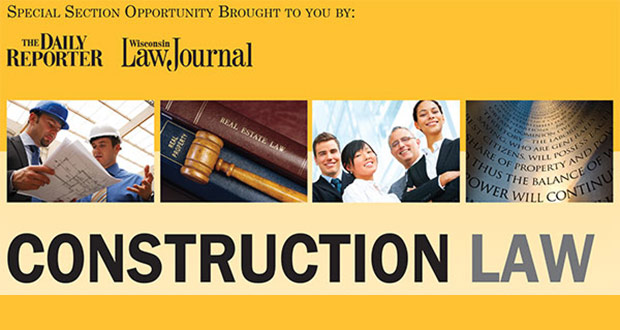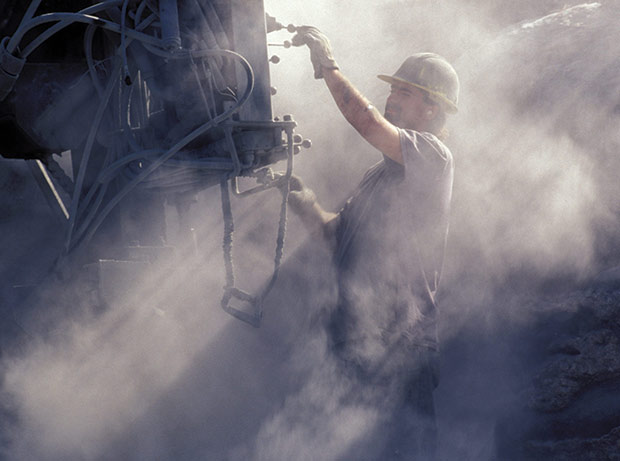New construction laws coming into focus
By: WISCONSIN LAW JOURNAL STAFF//March 29, 2016//
Recent legislation could help build a better Wisconsin
By Andrea L. Murdock
Halloin & Murdock, S.C.

Halloin & Murdock, S.C.
Warm weather means construction season in Wisconsin, and contractors across the state are out in force, changing and improving downtown skylines and local neighborhoods. But long before the actual construction work begins, owners and contractors must navigate state statutes and local ordinances governing construction projects to ensure that their projects are in line with current law.
In February and March, several bills affecting the construction industry were signed into law, and various others are on the horizon.
- Building Permits. 2015 Wis. Act 211 was passed by the Wisconsin Legislature in February and signed into law on March 1. Senate Bill 458 amends statutes relating to information required on building-permit forms and requires the establishment of an electronic system for building permits. The amendments set forth in SB 458 now require that to get a building permit, a contractor must provide a certificate of financial responsibility proving that the applicant has (a) a $5,000 surety bond or a $250,000 general liability insurance policy, (b) worker’s compensation insurance, if required by statute, and (c) made unemployment contributions or paid unemployment compensation taxes as required. The amendments also require that, by Jan. 2, 2017, the Department of Safety and Professional Services establish a system through which building permits may be submitted electronically to municipal authorities, as well as issued by them. The municipal authorities must begin implementation of the electronic building permit systems by January 2, 2018.
- Repair and Replacement of Nonconforming Use Structures. 2015 Wis. Act 223 was passed by the Wisconsin Legislature in February and signed into law on March 1. AB 523 concerns property owners rights to restore or replace nonconforming structures. A nonconforming use is a use of land, dwelling, or building that existed lawfully before the current zoning ordinance was enacted or amended, but that does not conform with the use restrictions in the current ordinance. Before their amendment, the statutes allowed municipalities to enact and enforce zoning ordinances prohibiting alteration of, addition to, or repair in excess of 50 percent of the assessed value of any existing nonconforming building, premises, structure, or fixture. The amendment set forth in AB 523 allows the owner of a licensed manufactured home to make repairs in excess of 50 percent of the assessed value, including an entire replacement, while still maintaining the legal nonconforming use. AB 523 also broadens an owner’s right to not only restore, but also replace nonconforming structures damaged by violent wind, vandalism, fire, flood, ice, snow, mold, or infestation.
- Sprinkler Ordinances. 2015 Wis. Act 176 was passed by the Wisconsin Legislature in February and signed into law later the same month. AB 568 amends state statutes concerning pre-existing sprinkler ordinances that impose requirements that are stricter than those found in the state’s multifamily-dwelling code. The statutes had previously allowed cities, villages, and towns to enforce pre-existing sprinkler ordinances that were stricter than the multifamily dwelling code. AB 568 amended the statutes to make clear that local sprinkler ordinances cannot be stricter than the requirements found in the multifamily-dwelling code.
- Inspections for Remodeling Projects. All newly built homes in Wisconsin require various inspections before they can be occupied. Inspection requirements for remodeled homes, however, vary among municipalities throughout the state. Senate Bill 87, which was passed by the Legislature in February, was drafted to deal with inspections for renovations of one- and two-family dwellings and to bring greater consistency to the quality of remodeling projects and the safety of homeowners. The newly proposed statute requires inspection of “major renovations of an existing structure,” which includes additions, remodeling, improvements, or other alterations of existing one- and two-family dwellings, if the total cost of the renovation exceeds 20 percent of the assessed value of the dwelling for property tax purposes. Repairs are not included in the scope of the proposed statute. The proposal is now awaiting consideration by Gov. Scott Walker.
- Regulation of Construction Near Navigable Waters and Wetlands. Under current law, an owner must obtain a permit from the state’s Department of Natural Resources to perform certain construction work in or near navigable waterways, particularly, areas of waterways considered “areas of special natural resource interest,” also known as ASNRIs. The ASNRI designation was designed to protect vulnerable areas of lakes, rivers, and streams. However, as currently worded, the law allows the DNR’s ASNRI designation to apply to an entire lake or river, even if only a small portion of the lake or river is designated as an ASNRI. In other words, the scope of the current law far exceeds the original intent. Senate Bill 459, which has been passed by the Legislature, is designed to narrow the scope of the ASNRI designation to only that portion that actually meets the criteria, thereby allowing owners greater property rights and construction options on and near navigable waterways. The proposal also changes the definition of “practicable alternatives” for wetland construction projects. Current law allows owners to fill any portion of a wetland for development only if they can prove that there are no practicable alternatives to taking such a step. Moreover, any “practicable alternatives” must take into account other land near the wetland, even if the land is not owned by the applicant. The proposed amendment would instead limit the need to consider “practicable alternatives” to only those found on land owned by an applicant, provided that two conditions were met. Namely, the project would have to (a) involve fewer than 2 acres of wetland, and (b) be limited to the construction or expansion of a single-family home, the construction or expansion of barn or farm buildings, or the expansion of a small-business project. However, lots created as part of a subdivision, land division, or other development initiated after July 1, 2012, would not be eligible for the limited review.
- Determining Setback from a Body of Water. Under current law, counties are required to enact shoreland setback areas, which are areas within a certain distance of the ordinary high-water mark of navigable waters in which the construction or placement of structures is limited or prohibited. Determining this setback area is a time-consuming regulatory burden. Assembly Bill 582, which has been passed by the Legislature, is designed to lessen this burden. AB582 will allow a professional, licensed land surveyor to measure and determine the setback for bodies of water, but only if the DNR has not already identified on its website the ordinary high-water mark for that particular body of water.
Knowledge of these recent changes will help contractors and owners work together to plan and build better projects in Wisconsin.
Legal News
- State Bar leaders remain deeply divided over special purpose trust
- Former Wisconsin college chancellor fired over porn career is fighting to keep his faculty post
- Pecker says he pledged to be Trump campaign’s ‘eyes and ears’ during 2016 race
- A conservative quest to limit diversity programs gains momentum in states
- Wisconsin prison inmate pleads not guilty to killing cellmate
- Waukesha man sentenced to 30 years for Sex Trafficking
- 12-year-old shot in Milwaukee Wednesday with ‘serious injuries’
- Milwaukee man convicted of laundering proceeds of business email compromise fraud schemes
- Giuliani, Meadows among 18 indicted in Arizona fake electors case
- Some State Bar diversity participants walk away from program
- Wisconsin court issues arrest warrant ‘in error’ for Minocqua Brewing owner
- Iranian nationals charged cyber campaign targeting U.S. Companies
WLJ People
- Power 30 Personal Injury Attorneys – Russell Nicolet
- Power 30 Personal Injury Attorneys – Benjamin Nicolet
- Power 30 Personal Injury Attorneys – Dustin T. Woehl
- Power 30 Personal Injury Attorneys – Katherine Metzger
- Power 30 Personal Injury Attorneys – Joseph Ryan
- Power 30 Personal Injury Attorneys – James M. Ryan
- Power 30 Personal Injury Attorneys – Dana Wachs
- Power 30 Personal Injury Attorneys – Mark L. Thomsen
- Power 30 Personal Injury Attorneys – Matthew Lein
- Power 30 Personal Injury Attorneys – Jeffrey A. Pitman
- Power 30 Personal Injury Attorneys – William Pemberton
- Power 30 Personal Injury Attorneys – Howard S. Sicula








